51 Brand New Esti-Mysteries! 4 Challenge Levels! All New Images!
If you’ve used the Esti-Mysteries from the original Esti-Mysteries blog post, or the 15 additional Esti-Mysteries that I wrote for 20 Days of Number Sense and Rich Math Talk, you’ll really enjoy this new set!
My goal was to write and post 51 brand new Esti-Mysteries between September and December.
The 51st Esti-Mystery was posted on Nov. 29, 2019.
After reading this blog post, take a look at THE 12 MOST POPULAR MATH STRATEGIES AND DOWNLOADS ON THIS BLOG.
How do Esti-Mysteries work?
If Esti-Mysteries are new to you, or if you have any questions about how to use Esti-Mysteries, please see the Q&A section below Level 500.
One other quick note.
Along the way, you’ll notice that I’ve also written a 2-hour course, called The Esti-Mystery Creator Course, that you are welcome to purchase if you’d like to have my tools and learn how to create your own Esti-Mysteries that are tailored specifically for your students. I’ve written quite a few Esti-Mysteries. There are about to be 51 new Esti-Mysteries posted here, so you may have plenty without ever taking the course. It’s a little tricky to keep up with all of the specific requests for Esti-Mysteries, so I wrote the course so that anyone who wants to learn how to make their own – tailored specifically for their students – will have all the resources to do so. If you are interested in learning how to write your own, you can find out more about the course here.
Also, if you would like to be notified when new Esti-Mysteries appear, please take a moment to subscribe to the blog.
Recommended: Here is a set of downloadable charts which students can annotate with each clue. Print out the charts and give each student their own copy of the chart. You’ll find 4 variations of the chart. Choose the ones that work for you and your students.
4 Printable Esti-Mystery Charts
51 Esti-Mysteries
Level 100 (Grades K-2)
Esti-Mystery 101 – “More Pieces Than You Can See”
Esti-Mystery 102 – “Shiny Rings”
Esti-Mystery 103 – “Bricks or Dominoes”
Esti-Mystery 104 – “Flying Cars K-2”
Esti-Mystery 105 – “Something Fishy”
Esti-Mystery 106 – “Red and Yellow”
Esti-Mystery 107 – “Bingo Lid”
Esti-Mystery 108 – “Two of Hearts”
Esti-Mystery 109 – “Brown Beads”
Esti-Mystery 110 – “Dominoes You See and Dominoes You Don’t”
Esti-Mystery 111 – “Block Talk, Level 1”
Esti-Mystery 112 – “Unleaded, Level 1”
Esti-Mystery 113 – “Gobs of Globes”
Esti-Mystery 114 – “Rocky Glass, Level 1”
Level 200 (Grades 1-3)
Esti-Mystery 201 – “Domino Dots”
Esti-Mystery 203 – “Lighter than Bricks”
Esti-Mystery 204 – “Length of Ribbon”
Esti-Mystery 205 – “Rocky Vase”
Esti-Mystery 206 – “The Return of the Rings”
Esti-Mystery 207 – “Block Talk, Level 2” (just updated)
Esti-Mystery 209 – “Unleaded, Level 2”
Esti-Mystery 210 – “Buttons Blue and Yellow, Too”
Esti-Mystery 211 – “Airplanes”
Esti-Mystery 212 – “Beads in a Bowl”
Esti-Mystery 213 – “Gobs of Globes, Level 2”
Level 300 (Grades 3-8)
Esti-Mystery 301 – “Not Carrot Sticks”
Esti-Mystery 302 – “Countdown”
Esti-Mystery 303 – “String Beads”
Esti-Mystery 304 – “Triangular Prisms”
Esti-Mystery 305 – “Three Containers of Dominoes”
Esti-Mystery 306 – “Flying Cars 3-8”
Esti-Mystery 307 – “Blue Rocks”
Esti-Mystery 308 – “Mirror, Mirror”
Esti-Mystery 309 – “Erasing Numbers”
Esti-Mystery 310 – “The Return of the Erasers!”
Esti-Mystery 311 – “Block Talk, Level 3”
Esti-Mystery 312 – “Yellow Hexagonal Prisms”
Esti-Mystery 313 – “Kazoom, Part 2”
Esti-Mystery 314 – “Rocky Glass, Level 3”
Esti-Mystery 315 – “Unleaded, Level 3”
Esti-Mystery 316 – “Gobs of Globs, Level 3”
Level 400 (Grades 3-12)
Esti-Mystery 401 – “Facing Prisms”
Esti-Mystery 402 – “Packing Peanuts”
Esti-Mystery 403 – “Advanced Bingo”
Esti-Mystery 404 – “Block Talk, Level 4”
Esti-Mystery 405 – “Prism Challenge”
Esti-Mystery 406 – “Where’s the Graphite?”
Esti-Mystery 407 – “Rocky Vase, Level 4”
Esti-Mystery 408 – “3 Gobs of Globes”
Q & A
The 5 Most Frequently Asked Esti-Mysteries Questions I Receive
I love the questions, so please keep them coming!
Q1. How do I get the Esti-Mysteries?
A1 Simply click on the hyperlinked titles above. When you do, you may see the PPT file download to your computer. If you don’t see it, check your download folder.
Q2. The Esti-Mysteries are PowerPoint files, but I use Google Slides. What do I do?
A2 Just save the PowerPoint file in your google drive. Then open it with google slides. I’ve used only animations that will work in both platforms, so once you open it with google slides, it will be completely ready.
Q3. How do I use the Esti-Mystery?
A3. I’ve made the Esti-Mysteries as user-friendly as possible. When you have the file on your computer, simply open it and play the slide show (you’ll see why that is so important in the next answer) and follow the directions on the screen.
Q4. When I come to The Reveal (shown below) I can’t find the answer. How do I get The Reveal to show the answer?
A4. Great question, and there is a really quick solution. When you use the Esti-Mysteries, simply make sure the slide show is playing in its presentation mode. For example, in PowerPoint, be sure to click on SLIDE SHOW then FROM BEGINNING. If you are using Google Slides, click on VIEW then PRESENT.
When the slide show is playing, all of the animations will work as expected. One of the key animations is that The Reveal box disappears and shows the answer which is beneath it. If the slide show isn’t playing, the disappear animation won’t be activated. The reason I’ve placed each answer beneath the reveal box is so that students won’t accidentally see it when you are opening up the file.
Q5. How can I show the clues one at a time – instead of all at once?
A5. This is actually the same answer as A1 above. If all of clues are appearing at once, then the slide show isn’t playing. Just follow the directions above and they will appear one at a time.
Q6. Should the students use charts?
A6. Yes. In almost every case*, I recommend that students should use a chart, write on the chart to cross out numbers that have been eliminated by the clues – or circle the ones that remain as possibilities – and continue to estimate and discuss their reasoning after each clue.
*There are some Esti-Mysteries, particularly in Level 300, Level 400, and Level 500 that require strategies that are more advanced than the use of the chart and/or are beyond the range of the chart. In those cases, I recommend that students use the strategies that will be more effective, but I won’t include any spoilers here. 🙂
Q7. What about whiteboards? Can the students simply write their answer on whiteboards without using the charts?
A7. For many other activities, I really like the use of individual whiteboards. For example, The Estimation Clipboard is a great activity for individual whiteboards on their own. However, for Esti-Mysteries, if that is the only tool that students are using – without an accompanying chart, then many of the Esti-Mysteries will become confusing for students. Follow the example below, and you’ll see exactly what I mean.
Below are the clues from the Esti-Mystery that is on my desktop right now. Let me briefly take you through a journey that 2 students might experience. Student 1 (with the chart) and Student 2 (without a chart)…
Before the first clue appears, both students select an estimate and then explain what number they chose and why they chose it. They are likely both pointing to the picture as they explain their reasoning. Let’s see what might happen after each clue appears to compare the experiences of these 2 students.
Student 1: Using their chart, circles all of the multiples of 3, from 3 through 51. (Notice that that experience is a useful practice in becoming familiar with the patterns and the multiples, and it allows the visual patterns on the chart to appear in a really interesting way.)
3, 6, 9, 12, 15, 18, 21, 24, 27, 30, 33, 36, 39, 42, 45, 48, 51.
Student 1 looks at the list of multiples, looks at the image again, considers which of the numbers still on the list appears to be the most reasonable estimate. Then the student chooses an estimate and explains what multiple they chose – and why they chose that number.
Student 2: Thinks about a multiple of 3 that seems like a reasonable estimate and writes it on their whiteboard (or blank piece of paper) and explains what multiple they chose as their estimate – and why they chose that number. (The estimate was 21)
Then clue #2 appears…
Student 1: Using their chart, eliminates all of the multiples of 3 (between 3 and 51) that include the digit 1.
3, 6, 9, 12, 15, 18, 21, 24, 27, 30, 33, 36, 39, 42, 45, 48, 51Student A considers the remaining possibilities, returns to estimation based on the remaining numbers and the image.
Student 2: Needs to write a new estimate. Thinks about what number is a multiple of 3, but does not include the digit 1. Thinks of a number that fits with both of those clues, and uses that number because it works – instead of truly revisiting the image and returning to estimation. (The new estimate is 33.)
Then clue #3 appears…
Student 1: Using their chart, eliminates all the remaining numbers that include the digit 4.
3, 6, 9, 12, 15, 18, 21, 24, 27, 30, 33, 36, 39, 42, 45, 48, 51It takes about 10 seconds to do.
Student A considers the remaining possibilities, revisits the image, and focuses on which of the remaining numbers is the most reasonable. Student A compares the image to the numbers and selects another estimate, and then explains to a partner what number they have now chosen – and why.
Student 2: Let’s say this time that the estimate that student 2 chose still works, so the student does not change the estimate. (The estimate remains at 33.)
Then the next clue appears…
Student 1: Quickly eliminates 3, 6, and 9 (because they are one-digit numbers) and 33 (because it does not include 2 different digits)
3, 6, 9, 12, 15, 18, 21, 24, 27, 30, 33, 36, 39, 42, 45, 48, 51
Student A considers the remaining possibilities, the image, and focuses on which number is the most reasonable.
Student 2: Recognizes that 33 doesn’t work and needs a new estimate. However, the student now needs to think back through all the layers of clues and try to think of a number that matches all 4 clues. Student 2 is focusing on going back to find a number (possibly any number) that matches the clues…
Student 1 is focusing on the most reasonable estimate…
Student 2 is trying to hurry to find a number that matches the clues rather than focusing on estimation. Student 2 settles on 30 because it matches the clues NOT because of that seems like the most reasonable estimate. Notice that student 2 hasn’t actually engaged with estimation or the concept of 2-digit numbers and doesn’t have solid estimation reasoning to discuss.
Then clue #5 appears…
Student 1: Quickly eliminates 30 and 36 on the chart (because they even numbers)
3, 6, 9, 12, 15, 18, 21, 24, 27, 30, 33, 36, 39, 42, 45, 48, 51
Student A now knows that the answer is either 27 or 39, and focuses on which of those is the most reasonable. This student is revisiting the picture, estimating, considering reasonableness, and discussing their ideas and hearing the ideas of others. An important note here is that the other students or students in the conversation are also discussing 27 and 39, so they can have a rich conversation about reasonableness, the image, and those 2 specific numbers.
Student 2: Needs to choose a new estimate. So this student tries to think of a number that is an odd number… and includes 2 different digits… and does not include the digit 4 or the digit 1… and is a multiple of 3. This student is not able to focus on estimation or reasonableness. Instead the student is simply trying to find a number that works.
Worth noting: There are some ways that a whiteboard on its own could be used effectively for this particular Esti-Mystery. For example, I used a list rather than a chart as context for the comparison above. Lists can work well when the sets are fairly small. However, when the first clue is “The answer is an odd number between 1 and 100,” the use of a list is far less practical.
In the end, I recommend providing each student with a chart to use.
Q8. Can I send you a specific math concept and have you write an Esti-Mystery around that concept?
A8. I typically do my best to respond to requests like this. However, since the school year becomes so very busy for all of us, and since there can be so many requests all at once, I realized that it would be better to write The Esti-Mystery Creator Course so that anyone who is interested in learning how to create Esti-Mysteries precisely for what their students are working on at any given time will be able to do so.
Q9. Some of the Esti-Mysteries have charts on them. Why is that?
A9. I typically include charts on the first few Esti-Mysteries of new sets to help students see how they might use a chart when they solve the Esti-Mysteries.
Q10. What is your biggest tip for using Esti-Mysteries?
A10. Make sure your students write down their estimate at the beginning AND after each clue. Most importantly, be sure that each time a new clue appears that students have a chance to discuss the clue, write down their new estimate, and explain to each other WHY they chose that estimate.
I truly hope you enjoy the 51 new Esti-Mysteries!
Thanks for visiting my blog!
All my best,
Steve
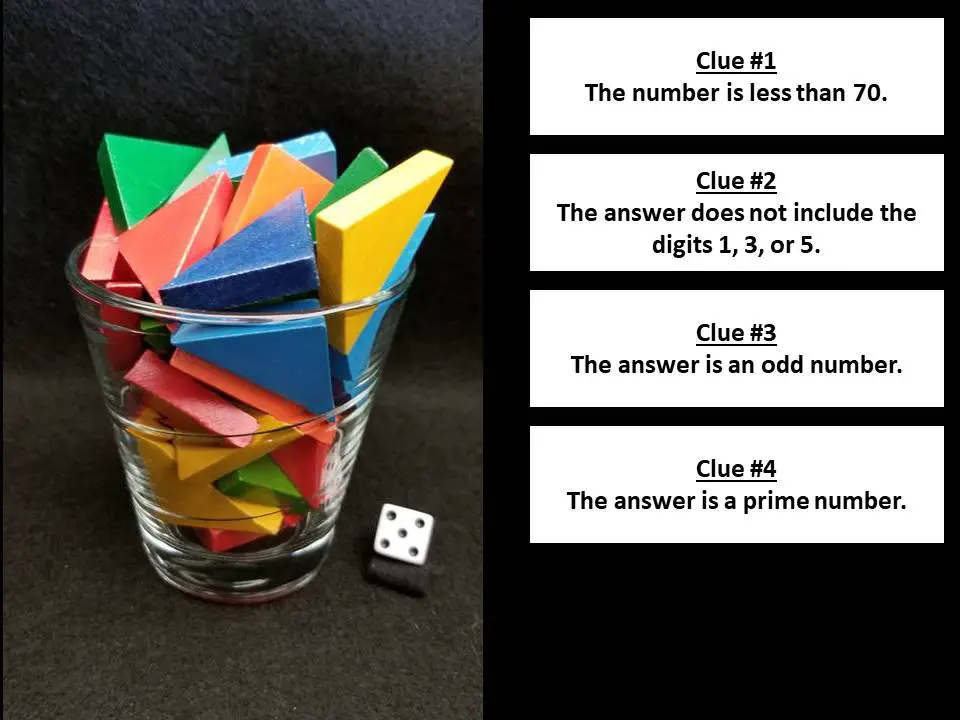
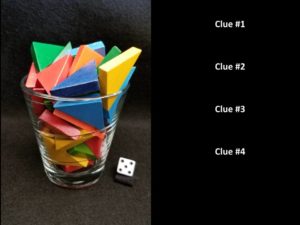

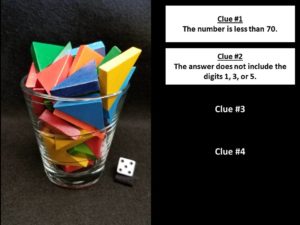
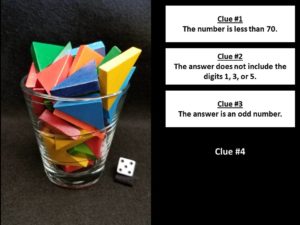
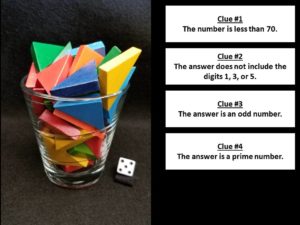







Leave a Reply